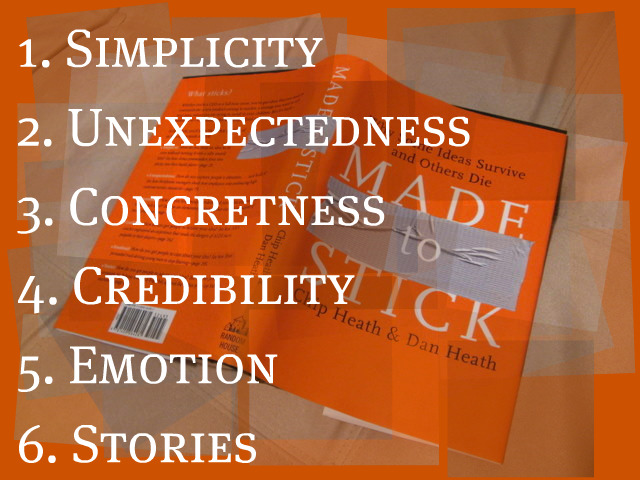What makes one idea stick and another fade?
What seeming intangibles do people with successful ideas grasp and implement better than rest of us?

In a world where technology, work and media move at a maddening pace, no one wants to be left behind. And it is a struggle to get anyone’s attention – not to mention holding it long enough to share an idea. A whole idea.
The title of Chip and Dan’s book “Made to Stick” sounds suitable for Marketing 101, and there is indeed a lot of material that can be used toward educating an audience of marketing majors. However, the ideas in this book are also universal in application – an idea that is made to stick can change a person’s behavior long after first exposure, it can remind a customer of a solution presented to him months before, and it can make or break a sale or a business decision, and in a nutshell, it can have large impact. The potential gain from a sticky idea is substantial if sufficient thought, creativity and preparation is put forth in advance into developing the ideas and making them unforgettable.
Reading is the best pastime for an active mind! If you like to see the other book reviews, check the index of In Print.
The Amazon reviews of this book ascribe the authors’ inspiration to Malcolm Gladwell’s “The Tipping Point”, a book I enjoyed immensely with the journeys into the human psyche – memory, emotion, decision, and behavior. I was sorely disappointed that I did not find any such parallels in “Made to Stick”. Nonetheless, I think the authors attempt and do succeed at writing a book that is beyond an average business book, as it shows us how to use stories and anecdotes and real life scenarios to make our ideas intriguing and lasting in the eyes of others.
The reading style is simple and characteristic of a good standard business book. The material is generally abstract, with relevant case studies and examples woven in. This will not be the most unforgettable business book or the most enjoyable one to read but it is also not a bad read. The chapters are organized remarkably well for the subject matter, and the authors carefully take us through the six major qualities of what they claim makes an idea stick:
- Simplicity: Strip your Idea down to the very core.
- Unexpectedness: Your Idea must be new; it must vary from preconceived notions of similar ideas.
- Concreteness: Use practical stories and real world applications to explain your Idea.
- Credibility: You as the owner of the idea must be or develop credibility as a person.
- Emotion: Appeal to emotion as you articulate your idea. It often makes people act.
- Stories: Telling the Idea in a story will captivate people.
While the book presents the six qualities through examples and case studies, it does not delve into ways to make your own ideas “stick” – From a historical and anecdotal perspective, it is well-researched and smartly written. From practicality standpoint, I would have liked to see examples of the authors taking average ideas, and turning them into intriguing ones using a clear approach.
My favorite section is the experiment with Tappers & Listeners (pg.19-20) which explains a fascinating theory: The Tappers & Listeners was a game studied by a PhD student. A tapper must tap out the rhythms of a song for listener. The listener must identify the song. The listeners were able to only identify 1 in 40 songs. What makes this very interesting is that the tappers guessed the listeners would identify 1 in 2 songs. Hence the theory: Just like music, when we explain an idea to others, there is a tune playing in our head, and it is nearly impossible to be in sync with the tune played in their head. They cannot hear our tune. This awareness helps you become better at explaining your ideas. When a CEO is explaining shareholder value to his employees, he is hearing a tune in his head that his employees do not hear. What fills that gap is the ability to make the ideas stick and communicate through the gap, and dodge what they term a the “Curse of Knowledge”.
Always communicate your ideas in simple, clear, universal language, and let details take care of themselves in due time.
 I am Farnoosh, the founder of Prolific Living. So glad you are here. My mission is to empower you to unblock your creative genius to live your dream life.
I am Farnoosh, the founder of Prolific Living. So glad you are here. My mission is to empower you to unblock your creative genius to live your dream life.